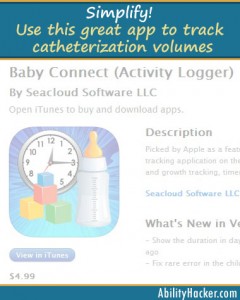 My husband Dan and I are a bit on the geeky side. We both seek out data like fruit flies to a banana, so when we received my daughter’s diagnosis of Myelomeningocele (more commonly known as Spina Bifida), we wanted information. LOTS of it.
My husband Dan and I are a bit on the geeky side. We both seek out data like fruit flies to a banana, so when we received my daughter’s diagnosis of Myelomeningocele (more commonly known as Spina Bifida), we wanted information. LOTS of it.
One of my most vivid memories is sitting side by side on the couch with a stack of medical documentation. It seemed like every 5th word was some convoluted medical term, so Dan grabbed his laptop and we went to work. I’d say (and spell) a word, he’d find the definition, and I’d make notes in the margin. After multiple hours, there was about as much of my handwriting on the page as the printed text.
One fact we learned: a person’s bladder and bowel nerves are located at the very end of the spinal chord. Meaning = when the spine is damaged, impaired bowel and bladder function is nearly guaranteed.
<insert wide eyed freaked out look>
I won’t lie. I was terrified to catheterize Lily in the NICU. However, they wouldn’t let us take her home until we learned, so learn we did.
Everyone told us it would become commonplace rather quickly, and they were right. But… logging and tracking urine output is pretty much a pain in the tuchus. While I love learning from data, I am NOT fond of collecting it. I can lose a sheet of paper in a matter of seconds, and keeping a paper log these days seems archaic. When we got home, we tossed the paper logs in the trash and reached for the magical machines we keep tucked in our pockets. There had to be an app for this!
We found BabyConnect (iPhone, iPad, Android, Windows Phone, Kindle Fire), which we still use today.
Why do we love BabyConnect?
- We use it on multiple devices (my iPhone, Dan’s iPhone, and an iPad), and it syncs in real time. No matter who records the data, it’s on all our devices automatically.
- When it’s time to visit Urology, we can export to Excel, make a scatterplot of her pee (which, by the way, is a fantastic visual), and email the log to her doctors.
- As it turns out, it’s pretty handy to track other data as well… breastfeeding times & supplementing volumes, times & types of medications given, stats like height, weight and head circumference, and much more. Let’s hear it for having all of this information in one place!
How do we use BabyConnect to track Catheterization volumes?
- Click on the Diaper icon.
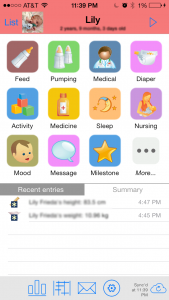
- Enter the volume in numbers into the Notes field. Describe the diaper if desired (poopy, wet, etc.). Click save.
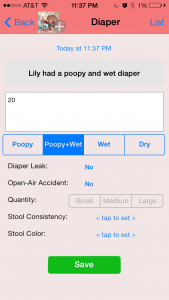
- To export logged volumes over a period of time, click on the envelope icon at the bottom of the home screen.

- Select CSV as the format. Select the date range using the “From” and “To” selectors. Move the Filter slider to ON (highlights in green when on). Move the Diaper slider to ON. Click “Generate Email” button.

- Enter your email address in the TO field. Modify the SUBJECT if desired. Click SEND.
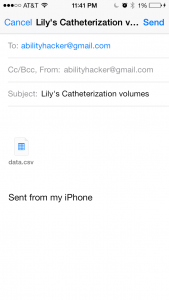
- Open the CSV file in Excel. Below is what it will look like.
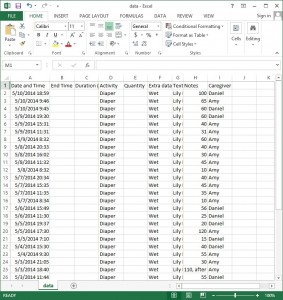
- Delete unnecessary columns and rename NOTES column to “Urine Output (ML)” (or whatever makes sense to you). Add rows at the top for your child’s name and birth date. If you feel adventurous, and want to add a cool chart, highlight the two columns of data, go to the INSERT tab, and click on the scatterplot icon.
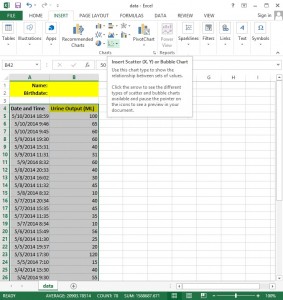
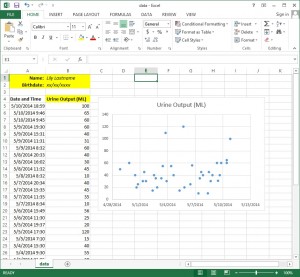
- Save your file and email it to your favorite Urologist.
Now, don’t lie. You think I’m crazy for scatterplotting my daughter’s pee, don’t you? It’s OK. I’m not hurt. But let me tell you why it’s NOT so crazy.
Having this chart allowed us to easily discuss the risks, pros & cons of putting Lily on bladder medicine with her doctors. It made advocating for her easier because the doctors could see with one glance that she is nearly always in a “safe” volume range, and as a result, we were able to keep her off a medicine that has some nasty side affects. If the picture looked different and she was in a “dangerous” volume range most of the time, then I think it would give me comfort knowing that dealing with the side affects was necessary to protect her kidneys.